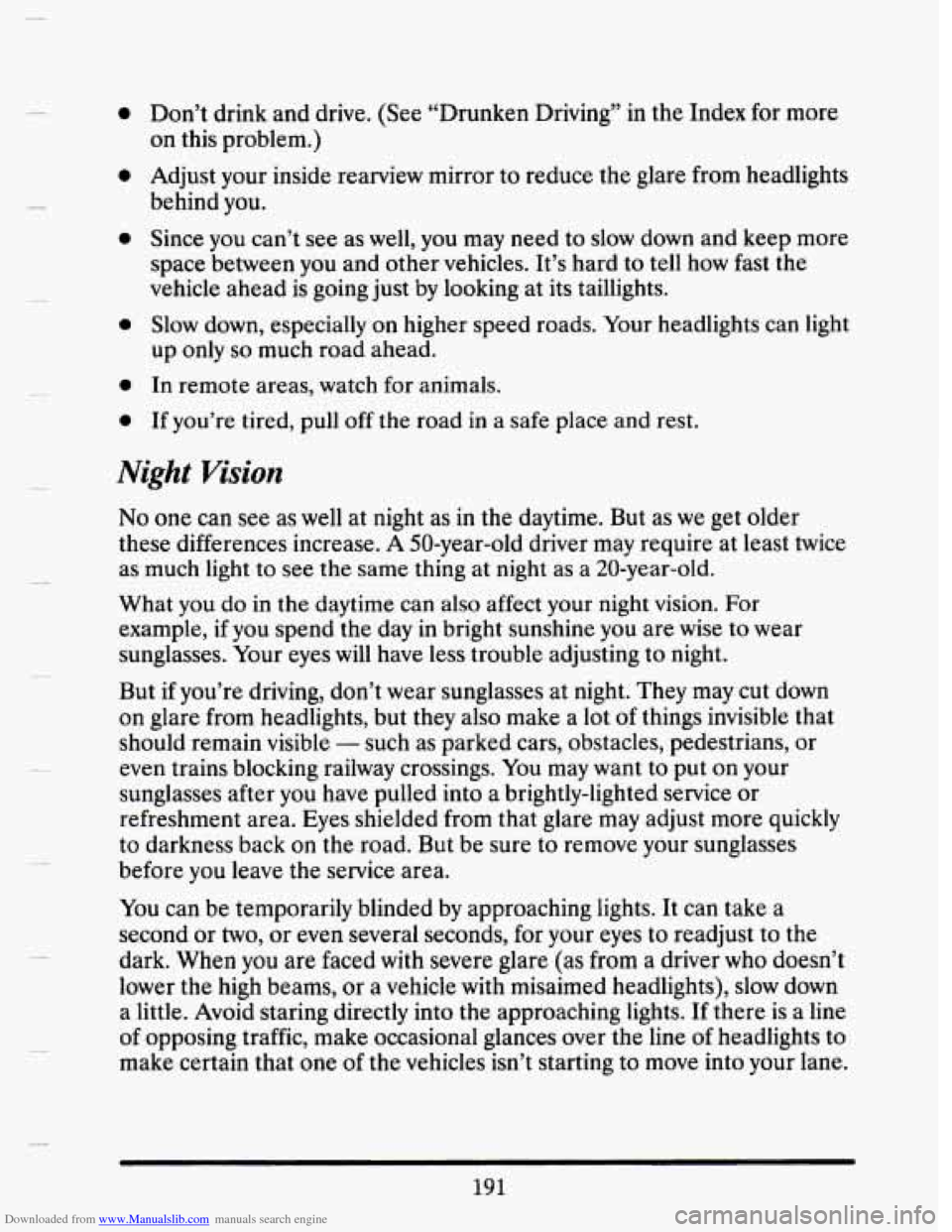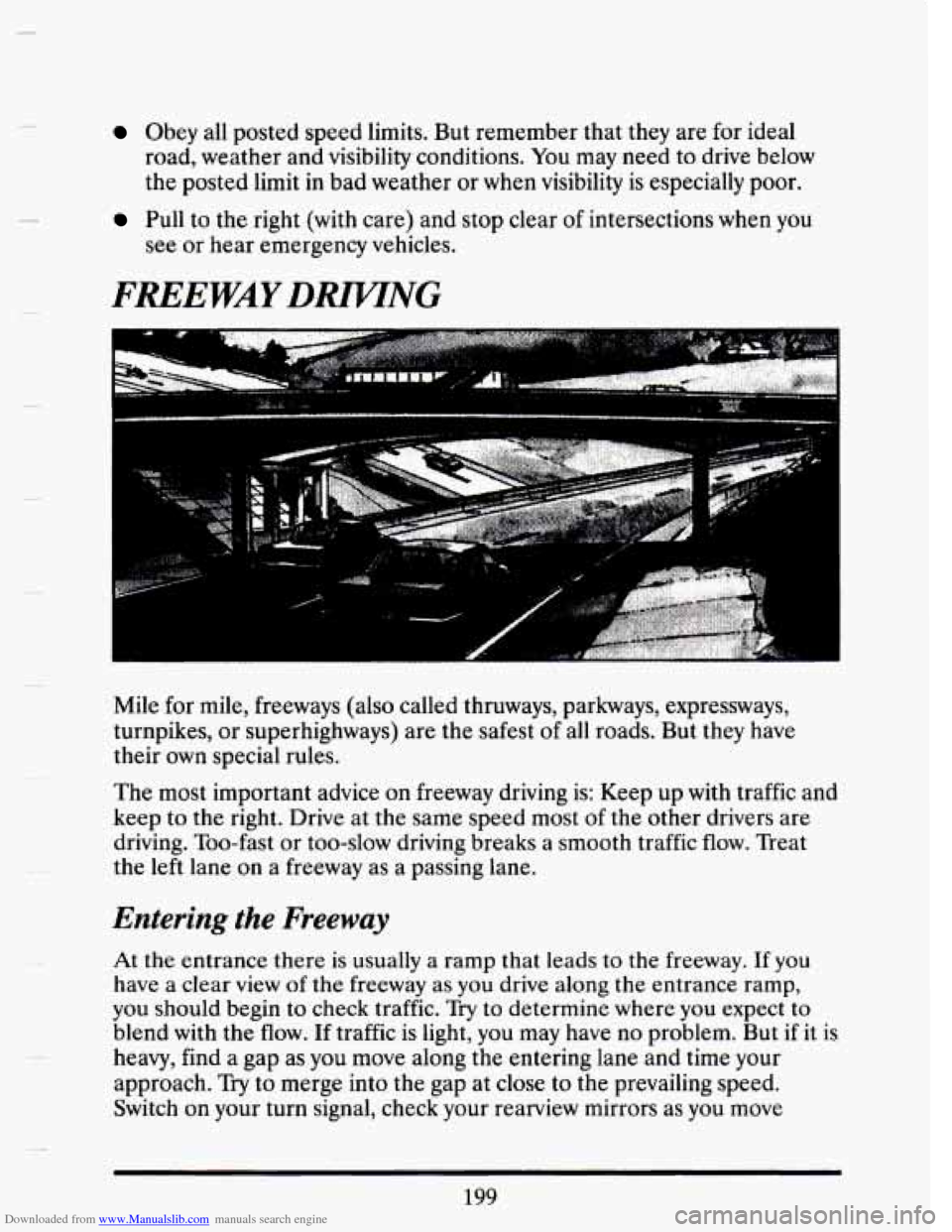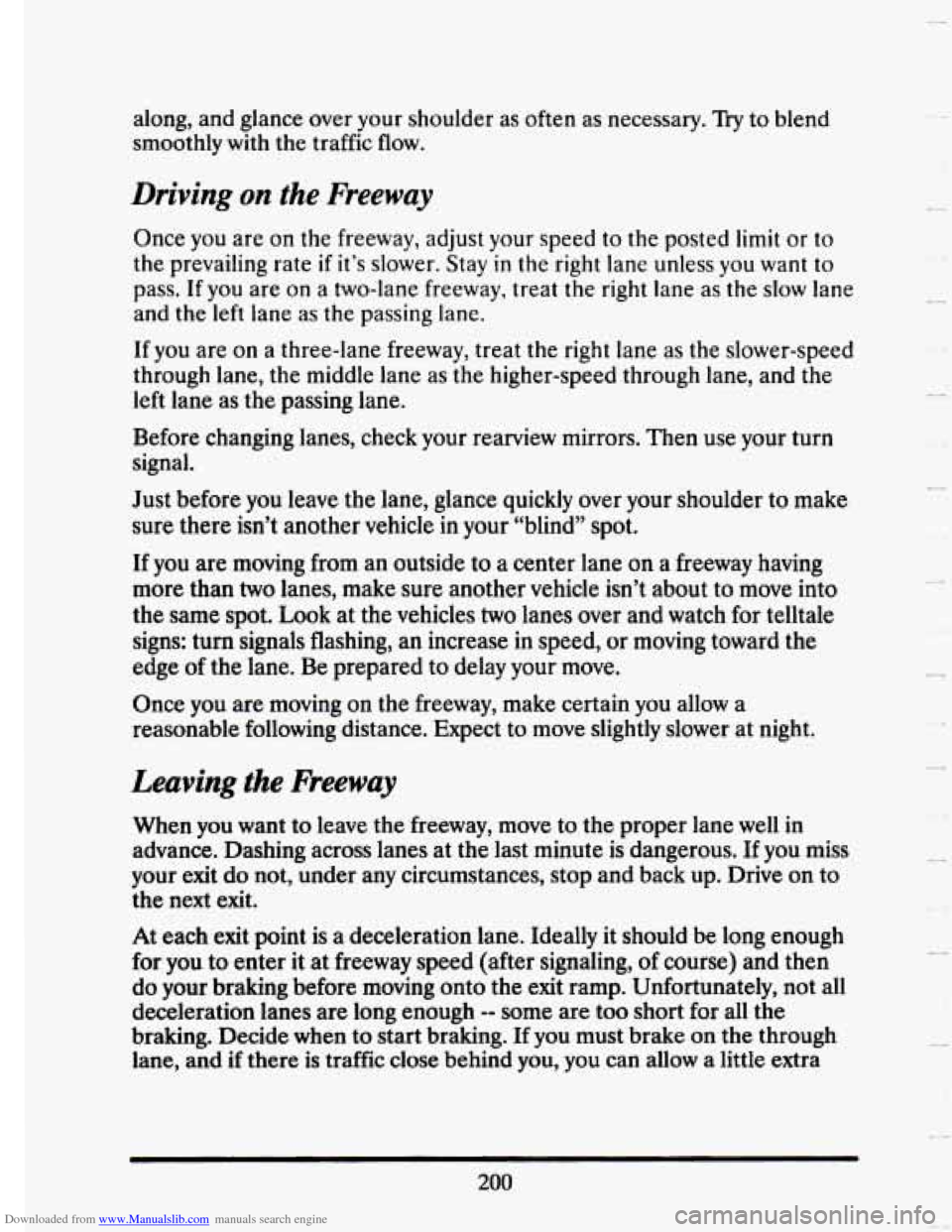Page 129 of 407
Downloaded from www.Manualslib.com manuals search engine MIRRORS
Inside DaylNight Rearview Mirror
To reduce glare from lights behind you, move the lever like this:
Automatic Inside Rearview Mirror
During the daylight it's like the standard mirror. But at night the system
goes to work.
During the day the mirror reflects
all the light from behind your car. At
night, when the glare
is too high, it darkens to reflect only part of the light
behind you. When
the mirror darkens, it holds that position until the
glare
is no longer present.
115
Page 130 of 407
Downloaded from www.Manualslib.com manuals search engine Settings
Your automatic rearview mirror has different positions for light
sensitivity. At the
"MAX" setting, bright headlights far away will cause
the mirror to gradually darken. This is a good setting for rural driving. At
the
"MIN' setting, bright headlights have to be rather close for the
mirror to darken. This is a good setting for city driving.
Reverse Gear Day Mode
off
116
Page 132 of 407
Downloaded from www.Manualslib.com manuals search engine Power Remote Control Mirrors
The control on the driver’s door armrest operates both outside rearview
mirrors. Move
the center switch to the left to select the driver side mirror,
or to
the right to select the passenger side mirror. Then press the control
pad to adjust each mirror
so that you can just see the side of your vehicle.
To lock the controls leave the selector switch in the middle position.
When
you operate the rear window defogger, it also warms both outside
mirrors to help clear them of fog or ice.
CONVEX OUTSIDE MIRROR
Your right side mirror is convex.
A convex mirror’s surface is curved so you can see more from the driver’s
seat.
118
Page 134 of 407
Downloaded from www.Manualslib.com manuals search engine To Open: Press the switch rearward to open the glass panel and sunshade.
The sunshade can also be opened by hand.
If you want to stop the roof in
a partially open position, press the switch in either diredtion to
stop it.
Press the switch again
to open it fully.
To Close: Press and hold the switch forward to close the glass panel. The
sunshade can only be closed by hand.
To Vent: Press the switch forward when the glass panel is closed. Open the
sunshade
by hand. To close the vent press the switch rearward.
SUNGLASS COMPRTMENT
If you have the optional Astroroof you will not have this feature. To gain
access
to this feature located directly above the inside rearview mirror in
the headliner, just push up and the compartment
will open.
120
Page 165 of 407
Downloaded from www.Manualslib.com manuals search engine Ip
i i
WAR DEFOGGER P
I"
c
P
P
F
F
r
Push this button to turn
on the rear defogger.
With it,
your rear
window and both
outside rearview
mirrors are
heated.
The system will
automatically shut
off
after 10 minutes. If
further defrosting is
desired, simply push
the button again.
Ekctronic Solar Sensor
The Electronic Solar Sensor is part of the Electronic Climate Control
System.
The sensor monitors
the sun's solar
radiation
by telling the
Electronic Climate
Control system at what
angle and intensity the
sun is. The Electronic
Climate Control uses
this information
to
automatically make
the necessary
temperature and
air
flow adjustments.
151
Page 205 of 407

Downloaded from www.Manualslib.com manuals search engine 0
0 0
0
0
Don’t drink and drive. (See “Drunken Driving” in the Index for more
on this problem.)
Adjust your inside rearview mirror to reduce the glare from headlights
behind
you.
Since you can’t see as well, you may need to slow down and keep more
space between you and other vehicles. It’s hard to tell how fast the
vehicle ahead is going just by looking at its taillights.
Slow down, especially on higher speed roads. Your headlights can light
up only
so much road ahead.
In remote areas, watch for animals.
If you’re tired, pull off the road in a safe place and rest.
Night Vision
No one can see as well at night as in the daytime. But as we get older
these differences increase. A 50-year-old driver may require at least twice
as much light to see the same thing at night as a 20-year-old.
What you
do in the daytime can also affect your night vision. For
example, if you spend the day in bright sunshine you are wise to wear
sunglasses. Your eyes
will have less trouble adjusting to night.
But
if you’re driving, don’t wear sunglasses at night. They may cut down
on glare from headlights, but they also make a lot
of things invisible that
should remain visible
- such as parked cars, obstacles, pedestrians, or
even trains blocking railway crossings. You may want to put on your
sunglasses after you have pulled into a brightly-lighted service or
refreshment area. Eyes shielded from that glare may adjust more quickly
to darkness back
on the road. But be sure to remove your sunglasses
before you leave the service area.
You can be temporarily blinded by approaching lights. It can take a
second
or two, or even several seconds, for your eyes to readjust to the
dark. When
you are faced with severe glare (as from a driver who doesn’t
lower the high beams, or a vehicle with misaimed headlights), slow down
a little. Avoid staring directly into the approaching lights. If there is a line
of opposing traffic, make occasional glances over the line
of headlights to
make certain that
one of the vehicles isn’t starting to move into your lane.
191
Page 213 of 407

Downloaded from www.Manualslib.com manuals search engine Obey all posted speed limits. But remember that they are for ideal
road, weather and visibility conditions.
You may need to drive below
the posted limit in bad weather or when visibility
is especially poor.
Pull to the right (with care) and stop clear of intersections when you
see or hear emergency vehicles.
FREEWAY DMNG
Mile for mile, freeways (also called thruways, parkways, expressways,
turnpikes, or superhighways) are the safest
of all roads. But they have
their own special rules.
The most important advice on freeway driving is: Keep up with traffic and
keep to the right. Drive at the same speed most
of the other drivers are
driving. Too-fast or too-slow driving breaks a smooth traffic
flow. Treat
the left lane on a freeway as a passing lane.
Entering the Freeway
At the entrance there is usually a ramp that leads to the freeway. If you
have a clear view of the freeway as you drive along the entrance ramp,
you should begin to check traffic. Try to determine where you expect to
blend with the flow. If traffic is light, you may have no problem. But if it is
heavy, find
a gap as you move along the entering lane and time your
approach.
Try to merge into the gap at close to the prevailing speed.
Switch on your turn signal, check your rearview mirrors as you move
199
Page 214 of 407

Downloaded from www.Manualslib.com manuals search engine along, and glance over your shoulder as often as necessary. Try to blend
smoothly
with the traffic flow.
Driving on the Freeway
Once you are on the freeway, adjust your speed to the posted limit or to
the prevailing rate
if it’s slower. Stay in the right lane unless you want to
pass.
If you are on a two-lane freeway, treat the right lane as the slow lane
and the left lane as the passing lane.
If you are on a three-lane freeway, treat the right lane as the slower-speed
through lane, the middle lane as the higher-speed through lane,\
and the left
lane as the passing lane.
Before changing lanes, check your rearview mirrors. Then use yo\
ur turn
signal.
Just before you leave the lane, glance quickly over your shoulder to make
sure there isn’t another vehicle in your “blind” spot.
If
you are moving from an outside to a center lane on a freeway having
more than
two lanes, make sure another vehicle isn’t about to move into
the same spot.
Look at the vehicles two lanes over and watch for telltale
signs: turn signals flashing, an increase
in speed, or moving toward the
edge
of the lane. Be prepared to delay your move.
Once you are moving on the freeway, make certain you allow a
reasonable following distance. Expect to move slightly slower at night.
Leaving the Freeway
When you want to leave the freeway, move to the proper lane well in
advance. Dashing across lanes at the last minute is dangerous.
If you miss
your exit do not, under any circumstances, stop and back up. Drive on to
the next exit.
At each exit point is a deceleration lane. Ideally it should \
be long enough
for you to enter it at freeway speed (after signaling, of course) and then
do your braking before moving onto the exit ramp. Unfortunately, not all
deceleration lanes are long enough
-- some are too short for all the
braking. Decide when to start braking.
If you must brake on the through
lane, and
if there is traffic close behind you, you can allow a little extra
200